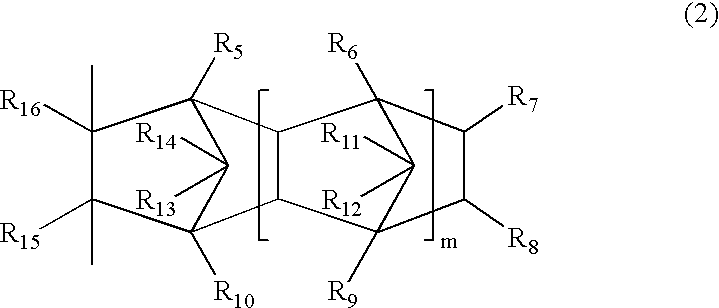Photoresist composition for deep ultraviolet lithography
a technology of applied in the field of deep ultraviolet light and composition, can solve the problems of 157 nm insufficient transparency of polymers, reaction scheme to introduce cyano groups into unsaturated bonds of alicyclic compounds, and high cos
- Summary
- Abstract
- Description
- Claims
- Application Information
AI Technical Summary
Benefits of technology
Problems solved by technology
Method used
Image
Examples
example 1
Synthesis of Methyl 2-Cyanoacrylate / T-Butyl Norbornene Carboxylate Copolymer
To a 35 (milliliter) ml pressure tube equipped with a Teflon coated stir bar and a threaded Teflon cap with O-ring was added MCA (1.46 g, 13.1 mmol), BNC (2.54 g, 13.1 mmol), THF (4 g), AIBN (120 mg) and acetic acid (200 mg). The reaction mixture was deaerated with nitrogen at a flow rate of 30 ml / min for 15 minutes. The vessel was then immediately capped tight using the Teflon screw cap. The vessel was placed in an oil-bath, which was preheated to 72.degree. C. The reaction was allowed to proceed for three hours. The viscous reaction mass was cooled to room temperature and diluted with 20.5 ml of THF. The solution was poured dropwise into 75 ml of hexane while stirring. The white polymer was filtered, washed with hexane and dried overnight in a vacuum oven at 55.degree. C. The isolated polymer had a yield of 64.6%. The polymer contained blocks of methyl cyanoacrylate. This block configuration yields acidic ...
example 2
Synthesis of Methyl 2-Cyanoacrylate / Norbornene Hexafluoro-Tert-Butanol Copolymer
To a 35 ml pressure tube equipped with a Teflon coated stir bar and a threaded Teflon cap with O-ring was added MCA (1.15 g, 10.4 mmol), NBHFtB (2.85 g, 10.4 mmol), THF (4 g), AIBN (120 mg) and acetic acid (200 mg). The reaction mixture was deaerated with nitrogen at a flow rate of 30 ml / min for 15 minutes. The reaction vessel was then immediately capped tight using the Teflon screw cap. The vessel was placed in an oil-bath, which was preheated to 72.degree. C. The reaction was allowed to proceed for three hours. The viscous reaction mass was cooled to room temperature and diluted with 20.5 ml of THF. The solution was poured dropwise into 75 ml of hexane while stirring. The white polymer was filtered, washed with hexane and dried overnight in a vacuum oven at 55.degree. C. The yield of polymer was 61.1%. The molecular weight was observed to be Mw=2730, Mn=1576, and PD=1.73. The polymer may be further rea...
example 3
Synthesis of Methyl 2-Cyanoacrylate / Norbornene Copolymer
To a 35 ml pressure tube equipped with a Teflon coated stir bar and a threaded Teflon cap with O-ring was added MCA (2.17 g, 19.5 mmol), NB (1.83 g, 19.5 mmol), THF (4 g), AIBN (120 mg) and acetic acid (200 mg). The reaction mixture was deaerated with nitrogen at a flow rate of 30 ml / min for 15 minutes. The reaction vessel was then immediately capped tight using the Teflon screw cap. The vessel was placed in an oil-bath, which was preheated to 72.degree. C. The reaction was allowed to proceed for three hours. The viscous reaction mass was cooled to room temperature and diluted with 20.5 ml of THF. The solution was poured dropwise into 75 ml of hexane while stirring. The white polymer was filtered, washed with hexane and dried overnight in a vacuum oven at 55.degree. C. The yield of the isolated polymer was 76.6%. The polymer was found to have a molecular weight of 11617 (M.sub.w) with PD of 1.86.
PUM
| Property | Measurement | Unit |
|---|---|---|
| of wavelength in the range | aaaaa | aaaaa |
| temperature | aaaaa | aaaaa |
| wavelengths | aaaaa | aaaaa |
Abstract
Description
Claims
Application Information
 Login to View More
Login to View More - R&D
- Intellectual Property
- Life Sciences
- Materials
- Tech Scout
- Unparalleled Data Quality
- Higher Quality Content
- 60% Fewer Hallucinations
Browse by: Latest US Patents, China's latest patents, Technical Efficacy Thesaurus, Application Domain, Technology Topic, Popular Technical Reports.
© 2025 PatSnap. All rights reserved.Legal|Privacy policy|Modern Slavery Act Transparency Statement|Sitemap|About US| Contact US: help@patsnap.com



